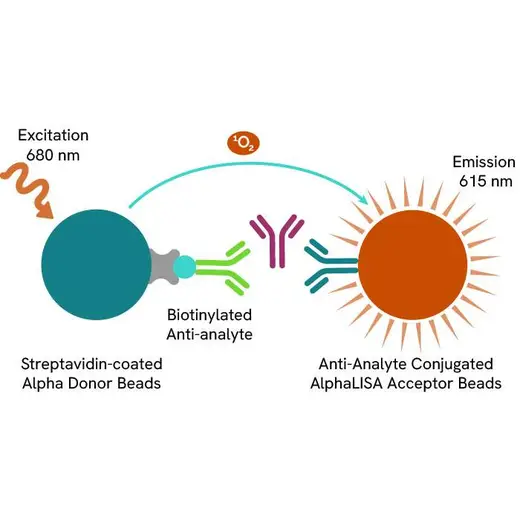
AlphaLISA Human ß-NGF Detection Kit, 500 Assay Points


 View All
View All
AlphaLISA Human ß-NGF Detection Kit, 500 Assay Points














The AlphaLISA™ Human Beta-Nerve Growth Factor (β-NGF) Detection Kit is designed for detection and quantitation of human β-NGF in cell culture medium and serum, buffered solution or cell culture medium in a homogeneous (no-wash steps, no separation steps) assay.
For research use only. Not for use in diagnostic procedures. All products to be used in accordance with applicable laws and regulations including without limitation, consumption and disposal requirements under European REACH regulations (EC 1907/2006).
| Feature | Specification |
|---|---|
| Application | Protein Quantification |
| Dynamic Range | 32.0 - 300,000 pg/mL |
| Limit of Detection | 32.0 pg/mL |
| Sample Volume | 5 µL |
The AlphaLISA™ Human Beta-Nerve Growth Factor (β-NGF) Detection Kit is designed for detection and quantitation of human β-NGF in cell culture medium and serum, buffered solution or cell culture medium in a homogeneous (no-wash steps, no separation steps) assay.
For research use only. Not for use in diagnostic procedures. All products to be used in accordance with applicable laws and regulations including without limitation, consumption and disposal requirements under European REACH regulations (EC 1907/2006).







AlphaLISA Human ß-NGF Detection Kit, 500 Assay Points







AlphaLISA Human ß-NGF Detection Kit, 500 Assay Points







Product information
Overview
Formats:
- Our 500 assay point kit allows you to run 500 wells in 96-well or 384-well format, using a 50 µL reaction volume (5 µL of sample).
- Our 5,000 assay point kit allows you to run 5,000 wells in 96-well or 384-well format, using a 50 µL reaction volume (5 µL of sample).
Features:
- No-wash steps, no separation steps
- ELISA alternative technology
- Sensitive detection
- Broad sample compatibility
- Small sample volume
- Results in less than 3 hours
- Half the time of an ELISA assay
Beta-Nerve Growth Factor (ß-NGF) contains 120 amino acids, is glycosylated, and forms homodimers in its mature form. It is a member of the nerve growth factor (NGF) family of neurotrophic factors that are involved in the differentiation, growth and survival of neuronal cells in the central and peripheral nervous systems. It is also a pleiotropic cytokine which may have an important role in the regulation of the immune system. Mutations in this gene have been associated with hereditary sensory and autonomic neuropathy, type 5 (HSAN5), and dysregulation of this gene's expression is associated with allergic rhinitis. ß-NGF is an important biomarker in certain neurological disorders such as Alzheimer`s disease.
AlphaLISA technology allows the detection of molecules of interest in a no-wash, highly sensitive, quantitative assay. In an AlphaLISA assay, a biotinylated anti-analyte antibody binds to the Streptavidin-coated Donor beads while another anti-analyte antibody is conjugated to AlphaLISA Acceptor beads. In the presence of the analyte, the beads come into close proximity. The excitation of the Donor beads causes the release of singlet oxygen molecules that triggers a cascade of energy transfer in the Acceptor beads, resulting in a sharp peak of light emission at 615 nm.
Specifications
| Application |
Protein Quantification
|
|---|---|
| Automation Compatible |
Yes
|
| Brand |
AlphaLISA
|
| Detection Modality |
Alpha
|
| Dynamic Range |
32.0 - 300,000 pg/mL
|
| Limit of Detection |
32.0 pg/mL
|
| Product Group |
Kit
|
| Sample Volume |
5 µL
|
| Shipping Conditions |
Shipped in Blue Ice
|
| Target |
β-NGF
|
| Target Class |
Biomarkers
|
| Target Species |
Human
|
| Technology |
Alpha
|
| Therapeutic Area |
Oncology
|
| Unit Size |
500 Assay Points
|
Image gallery






AlphaLISA Human ß-NGF Detection Kit, 500 Assay Points






AlphaLISA Human ß-NGF Detection Kit, 500 Assay Points






Video gallery

AlphaLISA Human ß-NGF Detection Kit, 500 Assay Points

AlphaLISA Human ß-NGF Detection Kit, 500 Assay Points

Resources
Are you looking for resources, click on the resource type to explore further.


How can we help you?
We are here to answer your questions.






























